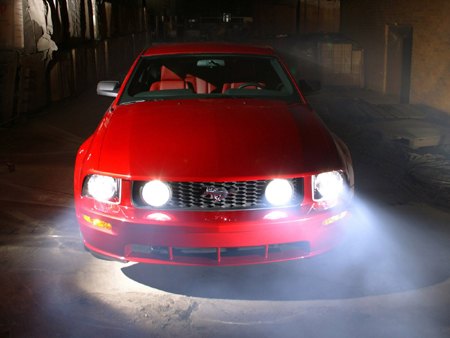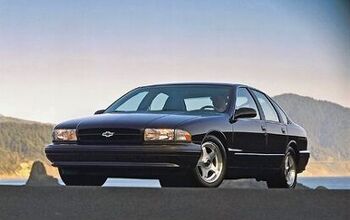Profit of Doom
Ford and GM are launching summer sales. The development reveals an open secret: the automakers are selling vehicles at a loss. There are plenty of reasons for this. The need to maintain cash flow, pay the Union, generate business for their finance arms and protect market share. But this trend can’t continue indefinitely. At some point, both of these companies need to produce profitable vehicles, and lots of ‘em. But what kind?
Back in the “good old days”, Detroit made its profits with middle and high end cars and pickup trucks. The Big Three only built small cars when recession and imports forced their hand. And no wonder: there wasn’t any “real money” in small cars– at least not for Detroit. Their bureaucratic manufacturing infrastructure and union obligations made it difficult to compete with smaller, leaner competitors. Besides, it wasn’t much more expensive to design or build a big vehicle than a small one, and they always sold for more money.
Eventually, American automakers surrendered the low-end domestic car market to the Japanese, Koreans and Germans. As the years went by, the foreign competition gradually moved its products up-market. Eventually, the Dai San launched luxury brands, created out of whole cloth (or leather). These were worrisome developments, but dismissible. Then, calamity: Detroit struck gold.
The SUV boom provided a serendipitous boost to the domestics’ bottom-line. The ability to sell cheap-to-build vehicles at a premium price was worth billions (and funded a large number of dubious foreign acquisitions). The SUV-fuelled “easy money” diverted The Big Three’s attention at the precise moment when non-Detroit brands were making serious inroads into the heart of the car market. Now that the SUV market has cooled, the Big Two are left playing catch-up, looking for a new cash cow. Unfortunately, the US car market has changed.
The middle market now belongs to the Japanese. Before the SUV boom, the Ford Taurus was a major force. Its two replacements, the Fusion and the Five Hundred, haven’t exactly set the class on fire. Although the Mexican-built Fusion is a solid sales success, it’s smaller and cheaper than its predecessor; which doesn’t bode well for profitability. The Five Hundred is big and plush and augurs more profit potential. But sales have been weak. GM wishes it had cars as distinctive (if underdone) as these. Meanwhile, Toyota, Nissan and Honda are banking huge profits on highly-evolved– and continually evolving– mid-market motors.
The size class above the middle has lost much of its volume and premium models to the SUV boom. The “near luxury” class is also packed with killer competition. BMW, Mercedes, Lexus and Audi have all reached down– joining Infiniti and Acura on their way up. This combination of superb products, badge snobbery and customer service has marginalized Cadillac and especially Lincoln. It’s worse yet for Buick. And Pontiac. And Mercury. And Saab. It’s hard to see what Ford or GM could do in the “near luxury” market to end well-earned “foreign” hegemony. Even when The Big Two own a successful niche player (Volvo), fierce competition in the segment makes for slim margins.
And then there’s the crisis looming in the truck market. Toyota and Nissan are bringing out new full-size trucks and ramping-up production capacity. The same industry wags who said building small domestic cars was a waste of time now say US truck buyers are too brand loyal to defect to the new guys. GM and Ford better hope so; neither company is in any condition to engage in an extended price war, and the loss of profits would be catastrophic to the rest of their holdings.
So where are the new “profit centers?” Only two American cars are enjoying strong, profitable sales success: the Ford Mustang and the Chrysler 300 (and its Dodge cousins). GM is planning a new Camaro to challenge the Mustang and maybe a rear-drive platform to challenge the 300. But both the Mustang and the 300 have no direct competition at present, making the new models’ potential success hard to judge. New, boldly-styled rear-wheel drive sedans may only fragment the existing market, rather than extend a profitable niche.
Which raises a scary question: even if Ford and GM come up with a hit vehicle or two, will they deliver life-sustaining profits? A spot on the top ten list may guarantee profitability, but the ever-expanding number of product niches– and the number of automakers in each niche– makes it harder for any one product to achieve large (i.e. profitable) volumes. The twin solutions: flexible manufacturing and foreign sales. Neither of which are Ford and GM’s strong suit. In fact, GM and Ford’s best chance for profit now lies in creating a spread of must-have vehicles in smaller runs. This strategy requires some serious money, which can only be generated by profits. Uh-oh.
More by Andrew Dederer
Latest Car Reviews
Read moreLatest Product Reviews
Read moreRecent Comments
- Joe65688619 Under Ghosn they went through the same short-term bottom-line thinking that GM did in the 80s/90s, and they have not recovered say, to their heyday in the 50s and 60s in terms of market share and innovation. Poor design decisions (a CVT in their front-wheel drive "4-Door Sports Car", model overlap in a poorly performing segment (they never needed the Altima AND the Maxima...what they needed was one vehicle with different drivetrain, including hybrid, to compete with the Accord/Camry, and decontenting their vehicles: My 2012 QX56 (I know, not a Nissan, but the same holds for the Armada) had power rear windows in the cargo area that could vent, a glass hatch on the back door that could be opened separate from the whole liftgate (in such a tall vehicle, kinda essential if you have it in a garage and want to load the trunk without having to open the garage door to make room for the lift gate), a nice driver's side folding armrest, and a few other quality-of-life details absent from my 2018 QX80. In a competitive market this attention to detai is can be the differentiator that sell cars. Now they are caught in the middle of the market, competing more with Hyundai and Kia and selling discounted vehicles near the same price points, but losing money on them. They invested also invested a lot in niche platforms. The Leaf was one of the first full EVs, but never really evolved. They misjudged the market - luxury EVs are selling, small budget models not so much. Variable compression engines offering little in terms of real-world power or tech, let a lot of complexity that is leading to higher failure rates. Aside from the Z and GT-R (low volume models), not much forced induction (whether your a fan or not, look at what Honda did with the CR-V and Acura RDX - same chassis, slap a turbo on it, make it nicer inside, and now you can sell it as a semi-premium brand with higher markup). That said, I do believe they retain the technical and engineering capability to do far better. About time management realized they need to make smarter investments and understand their markets better.
- Kwik_Shift_Pro4X Off-road fluff on vehicles that should not be off road needs to die.
- Kwik_Shift_Pro4X Saw this posted on social media; “Just bought a 2023 Tundra with the 14" screen. Let my son borrow it for the afternoon, he connected his phone to listen to his iTunes.The next day my insurance company raised my rates and added my son to my policy. The email said that a private company showed that my son drove the vehicle. He already had his own vehicle that he was insuring.My insurance company demanded he give all his insurance info and some private info for proof. He declined for privacy reasons and my insurance cancelled my policy.These new vehicles with their tech are on condition that we give up our privacy to enter their world. It's not worth it people.”
- TheEndlessEnigma Poor planning here, dropping a Vinfast dealer in Pensacola FL is just not going to work. I love Pensacola and that part of the Gulf Coast, but that area is by no means an EV adoption demographic.
- Keith Most of the stanced VAGS with roof racks are nuisance drivers in my area. Very likely this one's been driven hard. And that silly roof rack is extra $'s, likely at full retail lol. Reminds me of the guys back in the late 20th century would put in their ads that the installed aftermarket stereo would be a negotiated extra. Were they going to go find and reinstall that old Delco if you didn't want the Kraco/Jenson set up they hacked in?


































Comments
Join the conversation
Dave Clark, I have to disagree with you about the (minor) differences between the 300C, Magnum, and Charger. Tehy are closer than kissing cousins, however only the 300 offers any level of sophisticated style. Too back they don't carry a wagon variant here like they do in Europe. That said, I'm seeing more and more of the 300's pile up at the local dealer - 200 plus now - I think the "gotta have" crowd has moved on. Mustang GTs are a little harder to get, but the 6 cyls are all over the place. Finally, I look forward to purchasing a Mustang GT in the next 2 years...hopefully by then the interior plastics will improve, along with the appearance of satellite radion, steering wheel controls, and the disappearance of the radio mast. I can only hope.
Your timeline is a bit off. GM bought Saab and Ford bought Jaguar right at the beginning of the SUV boom, before it had started generating serious profits. They and Chrysler also diversified in more or less questionable ways back in the 1980s: Hughes, EDS, Gulfstream, etc. So their attention was diverted prior to the SUV boom. Many might argue that they never had a proper focus to be diverted from.